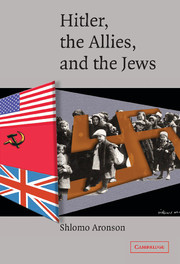Book contents
- Frontmatter
- Contents
- Preface
- Acknowledgments
- List of Abbreviations
- PART I THE MAKING OF THE MULTIPLE TRAP
- PART II THE RESCUE DEBATE, THE MACRO PICTURE, AND THE INTELLIGENCE SERVICES
- 10 Missed Opportunities?
- 11 The Intelligence Services and Rescue Options
- 12 The Jewish “Refugee Traffic”: The Road to Biltmore and Its Ramifications
- 13 American Wartime Realities, 1942–1943
- 14 Bermuda, Breckinridge Long, G-2, Biddle, Taylor and Rayburn, and Palestine Again
- 15 Roosevelt, Stimson, and the Palestine Question: British Inputs
- 16 The Views of Harold Glidden and/or British Intelligence, Consul General Pinkerton, and Rabbi Nelson Glueck
- 17 Various Methods of Rescue
- PART III THE SELF-DEFEATING MECHANISM OF THE RESCUE EFFORTS
- PART IV THE BRAND–GROSZ MISSIONS WITHIN THE LARGER PICTURE OF THE WAR AND THEIR RAMIFICATIONS
- PART V THE END OF THE FINAL SOLUTION: BACK TO HOSTAGE-TAKING TACTICS
- Epilogue: Self-Traps: The OSS and Kasztner at Nuremberg
- Notes on Sources
- Selected Bibliography
- Index
13 - American Wartime Realities, 1942–1943
Published online by Cambridge University Press: 22 July 2009
- Frontmatter
- Contents
- Preface
- Acknowledgments
- List of Abbreviations
- PART I THE MAKING OF THE MULTIPLE TRAP
- PART II THE RESCUE DEBATE, THE MACRO PICTURE, AND THE INTELLIGENCE SERVICES
- 10 Missed Opportunities?
- 11 The Intelligence Services and Rescue Options
- 12 The Jewish “Refugee Traffic”: The Road to Biltmore and Its Ramifications
- 13 American Wartime Realities, 1942–1943
- 14 Bermuda, Breckinridge Long, G-2, Biddle, Taylor and Rayburn, and Palestine Again
- 15 Roosevelt, Stimson, and the Palestine Question: British Inputs
- 16 The Views of Harold Glidden and/or British Intelligence, Consul General Pinkerton, and Rabbi Nelson Glueck
- 17 Various Methods of Rescue
- PART III THE SELF-DEFEATING MECHANISM OF THE RESCUE EFFORTS
- PART IV THE BRAND–GROSZ MISSIONS WITHIN THE LARGER PICTURE OF THE WAR AND THEIR RAMIFICATIONS
- PART V THE END OF THE FINAL SOLUTION: BACK TO HOSTAGE-TAKING TACTICS
- Epilogue: Self-Traps: The OSS and Kasztner at Nuremberg
- Notes on Sources
- Selected Bibliography
- Index
Summary
While in the United States early in 1942, David Ben-Gurion (and most of world Jewry) did not yet seem to realize the full extent of the Final Solution, partially due to its staged development into a full-fledged genocide. Ben-Gurion and the head of the embryonic Foreign Intelligence Service of the Hagana, Reuven Zaslani-Shiloah, used their visit in New York for the Biltmore Conference to meet with Arthur Goldberg, a labor lawyer in peacetime and the OSS Liaison Officer to foreign labor movements and social democratic parties. They suggested cooperation with the OSS in occupied Europe thanks to the Zionist network on the Continent that was mentioned earlier. Allen Dulles, the head of the OSS New York office, was interested in intelligence gathering, but nothing came out of that. Both Dulles and Goldberg were transferred abroad shortly after the meeting. Goldberg's main concern at the time was “to fight Fascism,” and later, following the American–British breakthrough from the Normandy beachhead, he perceived the war as being as good as won and returned to practicing law at home about a year before the war ended and with it the Final Solution.
Allen Dulles became the chief OSS agent in Europe and the recipient of rather early heartbreaking reports on death camps in Poland, which he does not seem to have forwarded to Washington.
- Type
- Chapter
- Information
- Hitler, the Allies, and the Jews , pp. 115 - 124Publisher: Cambridge University PressPrint publication year: 2004



